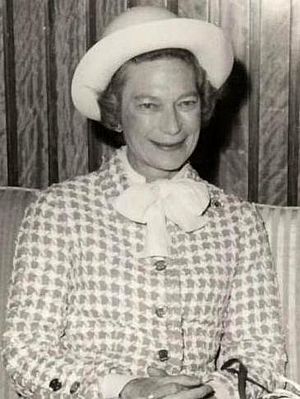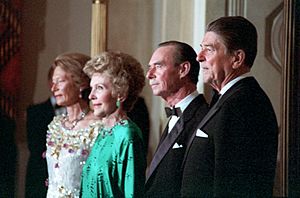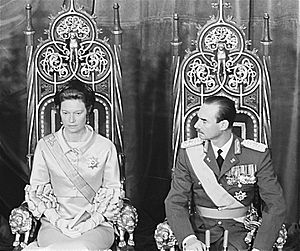Princess Joséphine-Charlotte of Belgium facts for kids
Quick facts for kids Joséphine-Charlotte of Belgium |
|||||
|---|---|---|---|---|---|

Joséphine-Charlotte in 1976
|
|||||
| Grand Duchess consort of Luxembourg | |||||
| Tenure | 12 November 1964 – 7 October 2000 | ||||
| Born | 11 October 1927 Royal Palace of Brussels, Brussels, Belgium |
||||
| Died | 10 January 2005 (aged 77) Fischbach Castle, Fischbach, Luxembourg |
||||
| Burial | 15 January 2005 Notre-Dame Cathedral, Luxembourg City, Luxembourg |
||||
| Spouse | |||||
| Issue |
|
||||
|
|||||
| House | Belgium | ||||
| Father | King Leopold III of Belgium | ||||
| Mother | Astrid of Sweden | ||||
Princess Joséphine-Charlotte of Belgium (born October 11, 1927, died January 10, 2005) was a very important person in Luxembourg. She was the Grand Duchess of Luxembourg, which means she was the wife of Grand Duke Jean.
She was the first child of King Leopold III of Belgium. Her brothers were King Baudouin and King Albert II, and she was the aunt of the current King Philippe. She was also related to other European royals, like King Harald V of Norway and Queen Elizabeth II.
| Top - 0-9 A B C D E F G H I J K L M N O P Q R S T U V W X Y Z |
Early Life and Family
Joséphine-Charlotte was born in 1927 at the Royal Palace of Brussels in Belgium. She was the oldest child and only daughter of King Leopold III of Belgium and his first wife, Princess Astrid of Sweden. She was baptized about a month after she was born.
Her godfather was her uncle, Prince Charles, Count of Flanders. Her godmother was Grand Duchess Charlotte of Luxembourg, who would later become her mother-in-law.
Joséphine-Charlotte's mother, Queen Astrid, was a very caring parent. She called her daughter "little Jo." The young Princess spent her childhood at the Stuyvenberg Palace near Brussels with her parents.
Tragically, her mother died in a car accident in 1935 when Joséphine-Charlotte was almost eight years old. The people of Belgium felt great sympathy for the grieving family. King Leopold remained a devoted father to his children.
In 1941, her father remarried to Mary Lilian Baels, who became Princess of Réthy. They had three more children: Prince Alexandre, Princess Marie-Christine, and Princess Marie-Esméralda. Joséphine-Charlotte and her siblings had a good relationship with their stepmother and called her "Mother."
Education and War Years
Joséphine-Charlotte first went to school at the Royal Palace, where a small class was set up for her. When World War II started, she and her brothers had to leave Belgium for a short time in 1940, going to France and Spain.
At the end of 1940, she returned to Brussels and studied at the Boarding School of the Faithful Virgin until 1942. After that, she continued her education with private teachers at the Royal Palace of Laeken, where her family was held captive during the war.
On June 7, 1944, the day after the Allied Forces landed in Normandy, France, she and her father were sent to Germany. They were kept under house arrest there. The Royal Family was finally freed on May 7, 1945. They then lived in Prégny, Switzerland, until 1950.
Joséphine-Charlotte continued her studies at École Supérieure de Jeunes Filles in Geneva, Switzerland. She took classes in French literature, English, history, and chemistry. She also studied child psychology at the University of Geneva.
Return to Belgium and Public Duties
On April 11, 1949, Joséphine-Charlotte returned to Belgium for the first time since the war. She had expressed her wish to come back earlier. She visited several towns, including Bastogne, Bande, Marche, and Namur.
She then arrived in Brussels, where she stayed at the Royal Palace of Laeken with her grandmother, Queen Elisabeth. She also visited Lichtervelde and La Panne.
The Princess returned to Belgium again to vote in a special public vote on March 12, 1950. This vote decided that the monarchy would continue in Belgium. After this, she began her official duties as a princess. She also became interested in social issues and the arts.
Marriage and Family Life
Joséphine-Charlotte first met Jean, Grand Duke of Luxembourg in 1948. This happened during one of her visits to her godmother, Grand Duchess Charlotte, in Fischbach.
Their engagement was announced to the public on December 26, 1952. Joséphine-Charlotte and Jean were married on April 9, 1953, in Luxembourg. They were married for 52 years and had five children:
- Princess Marie-Astrid of Luxembourg (born 1954)
- Henri, Grand Duke of Luxembourg (born 1955)
- Prince Jean of Luxembourg (born 1957)
- Princess Margaretha of Luxembourg (born 1957)
- Prince Guillaume of Luxembourg (born 1963)
Becoming Grand Duchess
When Joséphine-Charlotte became the Grand Duchess of Luxembourg, she brought a lot of grace and style to her new country. She took on many social, cultural, and humanitarian responsibilities. She was especially passionate about helping children and families.
After her husband, Jean, became Grand Duke in 1964, the family moved from Betzdorf Castle to the Berg Castle. Grand Duchess Joséphine-Charlotte was very involved in updating and renovating the castle.

As Grand Duchess, she often traveled with her husband on official visits to other countries. They visited places like the Vatican and Brazil in 1965, the United Kingdom in 1972, the USSR in 1975, and the United States in 1984. They also hosted 39 state visits to Luxembourg.
Joséphine-Charlotte became the president of the Luxembourg Red Cross in 1964. She also served as honorary president of the Luxembourg Philharmonic Orchestra. In 1990, she became the chief guide for Luxembourg’s guides movement. She supported many other organizations, including those for blood donors, children's health, and the Scouts and Guides of Luxembourg.
She also oversaw the restoration of the Grand Ducal Palace from 1991 to 1996. She regularly visited social and cultural centers, hospitals, and nurseries in Luxembourg.
Hobbies and Interests
Grand Duchess Joséphine-Charlotte loved gardening and growing plants. She also enjoyed outdoor activities like hunting, fishing, skiing, and other watersports.
She was also a collector of modern art. In 2003, an exhibition called De Manessier à Wim Delvoye showed 108 artworks from her personal collection at the National Museum of History and Art in Luxembourg.
Later Life and Legacy
The Grand Duchess had lung cancer for a long time. She passed away at her home, Fischbach Castle, at the age of 77 on January 10, 2005.
A metro station in Brussels is named after her: Joséphine-Charlotte metro station. One of her wedding gifts was a beautiful diamond tiara, known as the Belgian Scroll Tiara. This tiara is now part of the Luxembourg royal family's jewelry collection.
On December 5, 2016, a special concert was held in Luxembourg to honor Grand Duchess Joséphine-Charlotte. The Vienna Philharmonic Orchestra performed at this event.
Honours
National Honours
 Belgium: Knight Grand Cross of the Order of Leopold
Belgium: Knight Grand Cross of the Order of Leopold Luxembourg: Knight Grand Cross of the Order of the Gold Lion of the House of Nassau
Luxembourg: Knight Grand Cross of the Order of the Gold Lion of the House of Nassau Luxembourg: Knight Grand Cross of the Order of Adolphe of Nassau
Luxembourg: Knight Grand Cross of the Order of Adolphe of Nassau
Foreign Honours

 Denmark: Knight of the Order of the Elephant
Denmark: Knight of the Order of the Elephant
 Germany: Grand Cross Special Class of the Order of Merit of the Federal Republic of Germany
Germany: Grand Cross Special Class of the Order of Merit of the Federal Republic of Germany
 Greek Royal Family: Dame 1st Class of the Royal Order of Saints Olga and Sophia
Greek Royal Family: Dame 1st Class of the Royal Order of Saints Olga and Sophia
 Iceland: Dame Grand Cross of the Order of the Falcon
Iceland: Dame Grand Cross of the Order of the Falcon
 Japan: Dame Grand Cordon (Paulownia) of the Order of the Precious Crown
Japan: Dame Grand Cordon (Paulownia) of the Order of the Precious Crown
 Netherlands: Dame Grand Cross of the Order of the Netherlands Lion
Netherlands: Dame Grand Cross of the Order of the Netherlands Lion
 Norway: Dame Grand Cross of the Order of St. Olav
Norway: Dame Grand Cross of the Order of St. Olav
 Portugal: Dame Grand Cross of the Order of Christ
Portugal: Dame Grand Cross of the Order of Christ
 Spain: Dame Grand Cross of the Order of Isabella the Catholic
Spain: Dame Grand Cross of the Order of Isabella the Catholic
 Sweden: Member of the Royal Order of the Seraphim
Sweden: Member of the Royal Order of the Seraphim
 Thailand: Dame Grand Cross of the Order of Chula Chom Klao
Thailand: Dame Grand Cross of the Order of Chula Chom Klao
See also
 In Spanish: Josefina Carlota de Bélgica para niños
In Spanish: Josefina Carlota de Bélgica para niños




